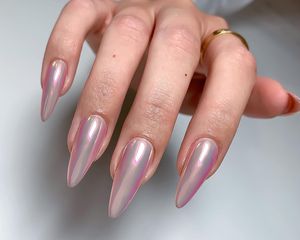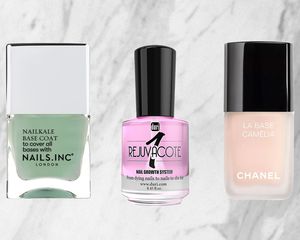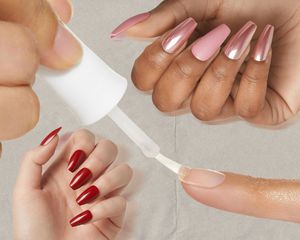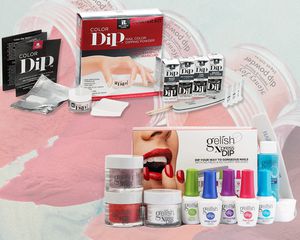:max_bytes(150000):strip_icc()/athomegels_recirc-dd74e9be73314d9bb4776da280c2ca32.jpg)
@gelcare.official / Instagram
Whether your schedule is too tight for a visit to the salon or you're trying to save a little money, there are plenty of reasons to DIY a gel manicure. Thanks to advancements in the products and techniques available to aspiring at-home manicurists, achieving a long-lasting gel manicure from the comfort of your couch is more feasible than ever. With practice and the right tools, a flawless gel mani can be (literally) at your fingertips.
Read on for our step-by-step tutorial for giving yourself an at-home gel manicure that will have everyone thinking you spent hours at the salon.
Meet the Expert
- Elina Ogawa is a professional celebrity nail tech represented by Bridge Artists based in New York City.
- Mazz Hanna is a celebrity nail artist and CEO of Nailing Hollywood.
What You'll Need
- UV or LED nail lamp for curing the gel polish
- Gel base coat and top coat
- Gel polish colors of your choice
- Nail file and buffer
- Alcohol wipes or nail polish remover for cleaning nails
- Cuticle oil
- Clean up brush (optional but highly recommended)
- Cuticle pusher and trimmer (optional)
- Nail primer (optional)
And there's one thing you'll want to do before you even pick up a nail file: Research. "Researching and understanding the entire process thoroughly before attempting gel manicures at home is key," says Nailing Hollywood CEO Mazz Hanna. "This includes knowing how to properly apply and cure gel polish and safely remove it. Doing gel manicures at home without proper training can lead to permanent nail damage and can even cause you to develop allergic reactions to gel polish."
Buff and File Your Nails
:max_bytes(150000):strip_icc()/fileshotfinal-eb3180aefa5247188f93fbeafacdeb42-54b997b954524ead954fd23218f80c73.jpg)
Ashley Rebecca
A long-lasting gel manicure lies in your prep work. This includes buffing and filing your nails and taking care of your cuticles.
Filing down the nailbed allows for the gel to better adhere to the nail. Stick to a traditional file for this step (like I did here). Celebrity nail tech Elina Ogawa doesn't recommend using nail drills at home: "They need a lot of practice and should be left to professional use," she cautions. "If you use a drill incorrectly, it's easy to damage your nails."
You'll also want to pay special attention to your cuticles. "The cuticles must remain clean because if any gel gets on your cuticles or skin, it will peel or lift," explains Ogawa. "You can gently remove dead skin from cuticles with clippers, [but] be cautious when removing any sensitive skin around the nails with sharp nail tools."
Clean Everything Up
:max_bytes(150000):strip_icc()/alcoholwipeshotfinal-0023f73bb79c44f08b6ec02493b7b2d4-0cd2e36646e8403e96791567b6b7e7f2.jpg)
Ashley Rebecca
After you're done buffing and filing, "remove any dust, oil, or debris on your nails before applying the gel," instructs Ogawa. Dust will leave your manicure looking bumpy, while oils, makeup, or skin or hair care products can cause your gel to shrink and reduce your wear time, she explains. To clean up my nails, I used alcohol prep pads.
Apply Your Base Coat
:max_bytes(150000):strip_icc()/basecoatshotfinal-da571466e5d945ecb2f99625faa59be2.jpg)
Ashley Rebecca
Once your nails have been buffed, filed, and wiped down, it's time for your base coat. I put on gloves to protect my hands once under the LED lamp, then applied the OPI Gel Color Stay Strong Base Coat ($20).
Ogawa suggests applying your first base coat and then curing for 30 seconds under the LED lamp. Follow up with another layer of base coat and cure for 30 more seconds before moving on to your color. I cured my nails with the Sunuv Sun2C UV Light ($32), which has four timer settings to keep track of the time (so you don't have to).
:max_bytes(150000):strip_icc()/ledcureshotfinal-4ed4ebb91ad84636b4fc745edb5625e3.jpg)
Ashley Rebecca
Byrdie Tip
While there are certain online retailers and beauty supply stores from which you can buy professional gel nail products, most will only be available to salon professionals.
Apply a Coat of Color and Cure
:max_bytes(150000):strip_icc()/firstcolorcoatshotfinal-eb49e61943b84216b6c89b79d425eca0.jpg)
Ashley Rebecca
Once the base coat has been applied and cured, you can move on to your color. I used OPI Gel Color in Cajun Shrimp, $20.
You'll want to go slow and steady while you paint. "Take your time and be patient," says Ogawa. "Rushing through the process can result in mistakes and uneven application." Adds Hanna: "Applying gel polish too thickly or not following the recommended curing times for your gel polish can cause the gel not fully to cure."
Always read the directions on your gel polishes for curing instructions—different polishes might have specific guidelines for curing—but in general, you'll want to cure each coat of polish for 60 seconds.
Byrdie Tip
"Invest In high-quality gel polishes and tools," Hanna recommends. "While it might be tempting to go for cheaper options, high-quality products can significantly affect your manicure's safety, outcome, and longevity."
Apply Your Second Coat and Cure
:max_bytes(150000):strip_icc()/secondcoatshotfinal-42c46a939da2491895c4391eb67a8aed-0f616bd269a143379786223383215af9.jpg)
Ashley Rebecca
After your first coat of polish is fully cured, apply your second coat. "Apply thin, even coats of gel polish and cap the free edge of your nails," instructs Hanna. Capping the free edge will help prevent premature chipping. Then, "use a clean-up brush to fix any mistakes before curing," she says. "A clean-up brush can help you achieve a salon-quality manicure at home."
Once your second coat has been applied, cure it under the LED lamp for another 60 seconds.
The Finisher: A Shiny Top Coat
:max_bytes(150000):strip_icc()/topcoatshotfinal-03df49c87e554cfea6a48845d34a799d.jpg)
Ashley Rebecca
To lock in your color and add that finishing touch of shine, your final step in painting should be applying your top coat. I applied a thin layer of OPI Gel Color Stay Shiny Top Coat ($20), capping the edges per Hanna's advice.
Once your top coat has been applied, Ogawa recommends curing it for 90 seconds to lock everything in and promote a full, long-wearing manicure. Once your nails have been cured, wipe them with another alcohol wipe to remove any excess residue.
While the steps are thorough, "do not skip prep work, base coat, or top coat," says Hanna. "If you skip these steps, your nails will chip and lift early—sometimes even immediately after application."
Condition With Cuticle Oil
:max_bytes(150000):strip_icc()/cuticleoilshotfinal-fb1bb50220db412b82dead6a34363392.jpg)
Ashley Rebecca
After your nails have been wiped down, adding a conditioning cuticle oil can help prevent dryness and add nourishment. Making this a regular practice can promote the longevity of your manicure. "Moisturize your nails and cuticles regularly to prevent dryness and lifting," recommends Hanna. I used Butter London Quick Slip Cuticle Oil ($22) around my cuticles.
Making Your Manicure Last
:max_bytes(150000):strip_icc()/handshotgelmani-535d7aa532f3435b8f5d0be2e54cc662.jpg)
Ashley Rebecca
To make your manicure last, "try not to use your nails as a tool," says Ogawa. "When you peel stickers off, when you open a can, when you open a box, if you don't use your nails as a tool, the gel will last much longer."
Hanna offered a list of tips for keeping your manicure picture-perfect:
- Practice proper nail care and maintenance between manicures. This includes keeping your nails hydrated, avoiding picking or biting at them, and using cuticle oil regularly.
- Avoid exposing your nails to harsh chemicals or excessive water for prolonged periods.
- Moisturize your nails and cuticles regularly to prevent dryness and lifting.
- Use gloves when doing household chores or using chemicals to protect your manicure.
- Consider applying an additional layer of top coat every few days to refresh the shine and extend wear.
Removal
When it comes time to remove your gel manicure, do so properly to keep your nails healthy and strong. "Avoid picking or peeling off your gel polish, as this can damage your nails," says Hanna. "Instead, ensure proper removal by soaking your nails in acetone." You know you've soaked long enough when the polish comes off with gentle scraping. (Your soaking time was insufficient if you have to force the polish off, says Hanna.) I use the Bask LA Steam Pro ($100) to remove my at-home gel manicures.





